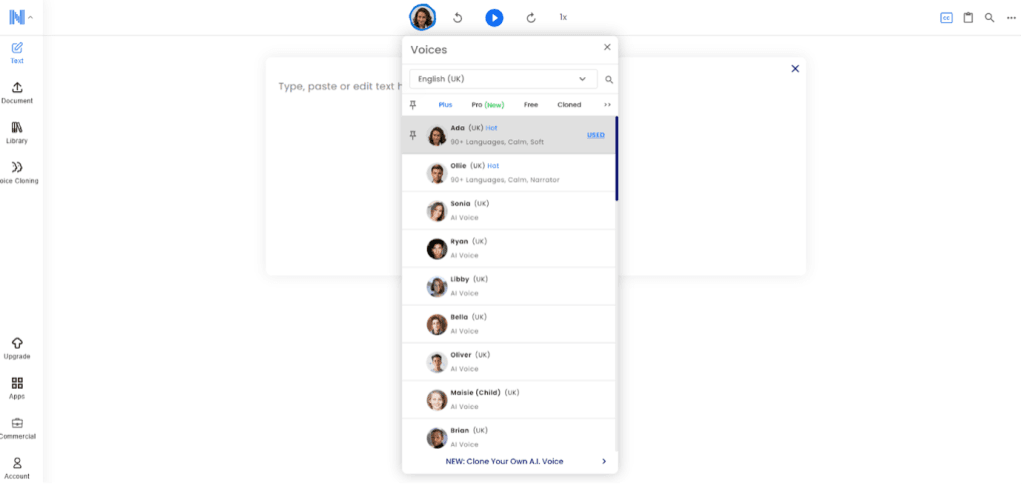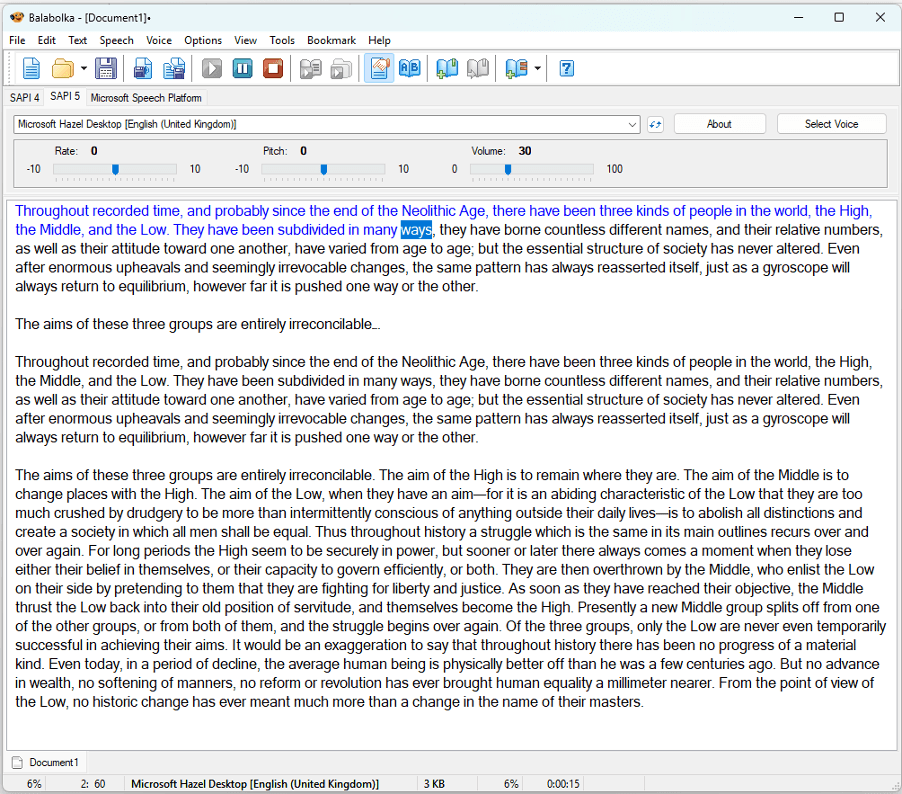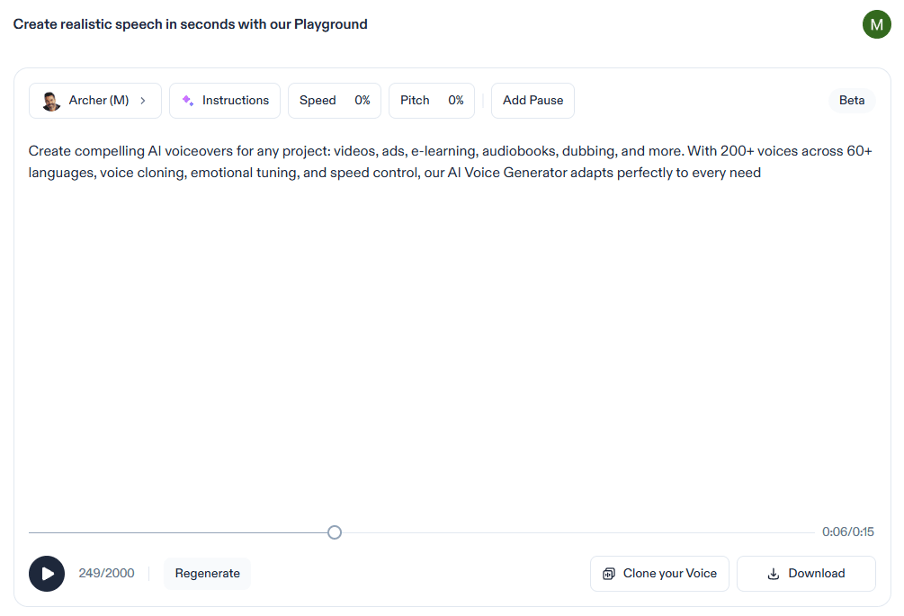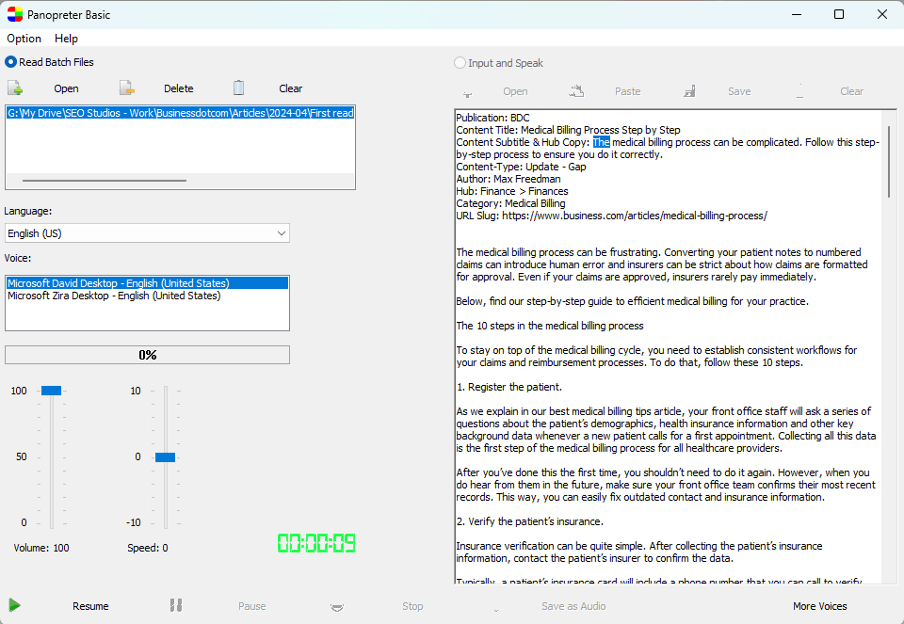Business.com aims to help business owners make informed decisions to support and grow their companies. We research and recommend products and services suitable for various business types, investing thousands of hours each year in this process.
As a business, we need to generate revenue to sustain our content. We have financial relationships with some companies we cover, earning commissions when readers purchase from our partners or share information about their needs. These relationships do not dictate our advice and recommendations. Our editorial team independently evaluates and recommends products and services based on their research and expertise. Learn more about our process and partners here.
Best Free Text-to-Speech Software for 2025
Turn your notes, PDFs and even web pages into audio files with these free text-to-speech software titles.

Table of Contents
Creating audio content for your business doesn’t mean you have to invest in expensive production tools or hire voice actors. For businesses with an occasional need for audio, free text-to-speech software is a practical solution, helping you to create usable voice files from everyday documents for training, marketing and accessibility use cases.
In this article, we review four of the best free text-to-speech software providers for business use. You’ll also discover which ones produce the most natural-sounding speech and support multiple languages as well as what features matter the most when choosing the right platform for your business.
What is the best free text-to-speech software available?
We examined nine different text-to-speech platforms, some entirely free and others offering paid-for options as well as a free plan. These four made our final list because each one stands out as the best option for a specific business use case.
Natural Readers

Best for: Creating high-quality voiceovers for use in IVR queues and presentation and marketing materials.
Natural Readers is an AI-powered browser-based text-to-speech platform, offering users a selection of voice and language options.
What stood out about this free software was its contextual awareness. In other words, it infers the emotion behind a block of text and adjusts to it. For example, let’s say it comes across a line like “You’re leaving? After everything you promised? That’s unbelievable!” It might read the first part of the phrase with a questioning tone, adding extra emphasis to “everything” in the second section to express frustration. It may even sound angry and raise its voice for the last sentence.
There are paid options on the site but, to access the free tier, click “Get Started” and select “Personal” from the drop-down menu. The free app also includes these features:
- Create audio for PDFs, Word documents and website links
- Clone your own voice using a microphone or audio file
- Choose from three accents per country (over 200 on paid)
- Generate up to five minutes of output per day (500,000 words/day on paid)
- Control rate of playback by adjusting playback speed or setting by words per minute
- Add pause times between sentences and paragraphs
- Speech volume control
Apps are available for Windows, browsers and smartphones running either Android or iOS.
Pros | Cons |
|---|---|
|
|
Balabolka

Best for: Batch conversions and off-line reading
Unlike newer platforms like Natural Readers, Balabolka is a desktop app built on Microsoft Speech API. It offers 13 different voices (12 American and one British) in the English language. Via the Microsoft Speech API, a total of 26 languages are available, including Spanish, Portuguese, French, Italian and German.
It works with a wide range of file types including Microsoft Word documents, Excel files and e-books. Text loads into the Notepad-style windows where you can easily edit it. We liked these features the software offered:
- Adjustable voice rate, pitch and volume
- Homograph finder for the correct pronunciation of words with the same spelling but different meanings based on context, like the verb and noun “lead”
- Ability to switch speaking voice (for example, choose one voice for a narrator and another for an interviewee or character)
We really appreciate how the authors still keep this older app up to date. Don’t expect voices as convincing as ElevenLab’s or Natural Readers – think more the voice on a telephone queueing system 15 years ago. Still, it’s completely free and offers unlimited text-to-speech generation.
Pros | Cons |
|---|---|
|
|
Speechify

Best for: Managing voice content from different channels in one workspace
Speechify does have a free option but accessing it takes a bit of work. You will need to create an account and answer a short onboarding questionnaire. Then you’ll see a subscription page offer. To get the free version, go back to the home page and log in again.
Now, you’ll be able to convert documents from cloud storage services like Google Drive, Dropbox, OneDrive or from your own system. Alternatively, write new text in your browser, paste in a web link or get it to use its OCR to scan a page.
The free version restricts you to five of the Microsoft Speech API voices, all of which sound quite robotic. For this review, we tested the free trial, which unlocks an additional 249 voices. They all sound a lot more natural but not to the standard of, for example, Eleven Labs. Other paid benefits include the ability to skip over elements like headers, footers, citations and brackets automatically.
The free version also offers:
- A dashboard containing previous text-to-speech projects nearly lined up in rows with mini-screenshots
- Quick access buttons to add files and enter web links to turn into speech
- The ability to create folders where you can group together related projects
Speechify is available on browsers and in iOS, Android, Mac, Chrome and Edge apps.
Pros | Cons |
|---|---|
|
|
Panopreter

Use “Read Batch Files” for Panopreter to read Microsoft Word and text documents or “Input and Speak” to enter text into the right-hand window. Source: Panopreter.
Best for: Quickly converting text files into audio for review and follow-up
Like Balabolka, Panopreter relies on the Microsoft Speech API for its voices. You get a choice of 49 language and language variations (for example, UK English and U.S. English), 49 male voices and 32 female voices. However, the voices sound robotic in comparison to modern AI-driven tools, although they’re not unpleasant.
There are two versions, both of which use a desktop app: a free basic edition and a paid standard edition ($32.99 one-off). Features we like include:
- Upload files or type in your own text to turn into speech
- Adjustable speech speed and volume
- Save output as WAV or MP3
There are limitations. You have to restart the app to switch between file upload and text inputs. We like how, when you upload a file, it pastes the copy into the speech window but it’s a pity you can’t edit it here. It’s also only available as a desktop app.
On the upside though, you never pay for turning your text into speech and we love the file batching for processing large volumes of content quickly.
Pros | Cons |
|---|---|
|
|
Which free text-to-speech software offers the most natural-sounding voices?
Natural Readers offers the most natural-sounding voices out of all the free text-to-speech software we reviewed with Speechma (see below) a close second. Some of the outputs were so convincing that we could see them being used in video marketing or the voices behind call center software, with most people likely not realizing they were listening to synthetic speech.
Are there any free text-to-speech programs that support multiple languages?
Two free text-to-speech programs that support multiple languages include:
- TTSMaker: TTSMaker supports English, French, German, Spanish, Arabic, Chinese, Japanese, Korean, Vietnamese and dozens of other languages. There are a few constraints: first, you need to pass a Captcha code test for each TTS pass and second, there is a 3,000-character limit. We do like how easy it is on TTSMaker to download your audio files.
- Speechma: Speechma also provides a wide range of language and country-specific accents. Downloading is easy although the 2,000-character is a significant limiter on output. Like TTSMaker, you need to enter a Captcha code before voice generation. The voice is excellent on the platform and the only reason we did not include it in our top four was that it’s more of a web feature than an actual online or offline platform.
What are the key features to look for in free text-to-speech software?
Look for the following key features in free text-to-speech software when choosing a platform for your business:
Natural-sounding speech
Before generative AI, many TTS apps, free or paid for, were powered by robotic sounding voices. Choose one of the many platforms now outputting voices that are clear, lifelike and feature natural intonation and cadence. “The best TTS tool is the one that doesn’t make your audience realize it’s a tool,” Andrew Romanyuk, co-founder of Pynest, told business.com. “Avoid free tools that sound robotic because the pacing is off or the emphasis is incorrect.”
Svetlana Kouznetsova, a B2B accessibility strategy consultant, agreed. “Poorly rendered speech places a high cognitive load on the listener because trying to understand poor-quality automated speech is truly exhausting. High-quality voices make content more engaging and much easier to comprehend.”
Narrative style customization
Go for AI-powered TTS software that allows you to set the voice tone and speed to match your script, or has software that can do this for you automatically.
Pausing
Prioritize software that offers greater control, like the ability to insert specific pause lengths so the narration sounds less rushed and more natural. Most platforms pause when they get to commas, periods and colons and the timing can feel slightly off with it being either too short, too long or just not quite natural-sounding.
Own voice cloning
Some free and many paid-for TTS platforms allow you to clone your own voice. Test-drive a few platforms to see which one sounds most naturally like you. You’ll have to speak into a microphone or upload audio of yourself for the software to be able to recreate your voice.
Choice of source materials
While typing or pasting in content to a text box is easy, sometimes it’s just easier to upload a file like a PDF or point to a weblink. If you’ll be mainly turning PDF text into speech, look for a service with Optical Character Recognition (OCR) to read text from images.
Searchability
A valuable feature is the ability to organize text and audio files into folders so you can find specific projects again easily.
Real-time text highlighting
Some platforms highlight words on the screen as they are spoken. “This feature improves comprehension by allowing you to follow the audio visually,” said Bryan Forrester, CEO of Boostlingo. “This can be really useful for proofreading and learning who benefit from multisensory input.”
Choice of languages
For companies serving customer bases that use different languages, especially Spanish, choosing software that supports these languages means you can create content tailored to each market.
Choice of dialects/accents
For international brands, look for options to select specific regional dialects and accents. Using a local accent, such as UK or U.S. English, makes audio content more relatable and effective for both local customers and employees.
Commercial use rights
“Make sure the option you select allows your business to legally deploy the tool in client-facing or monetized environments,” recommended data and AI strategist Vinod Goje. This means checking the licensing terms carefully, as many free or academic-use models may not be permitted in commercial applications.
How does text-to-speech software work?
Modern TTS platforms are complex and the technology they use has a direct impact on voice quality. “Not all text-to-speech (TTS) is created equal,” explained Gaea Vilage, marketing director of ReadSpeaker. “While many systems now produce natural-sounding voices, what happens behind the scenes varies significantly and that impacts everything from reliability to brand trust.”
There are three processes that happen in text-to-speech software:
- Text processing: First the text is scanned so the software can identify different text elements. The next stage is normalization where the software makes sure that it reads the text out in the correct way. For example, that could be dates like 07/16/2026 becoming “July 16 2026,” abbreviations such as “Dr.” turning into “doctor” or listing currency as “ten dollars” instead of “$10.”
- Linguistic analysis: After processing, the next step is breaking each word down into individual phonemes, the smallest units of sound. Examples include the “d” in “dog” or “sh” in “ship.” The software then tries to predict the way to deliver the speech, altering rhythm, stress and intonation to match expected human speech patterns.
- Waveform synthesis: The final stage is the production of speech itself. Older systems use concatenative synthesis which stitches together individual clips. That’s why it sounds disjointed and suffers from poor flow. Modern platforms use neural synthesis to generate the voice from scratch, which sounds far more fluid and natural sounding.
FAQs
